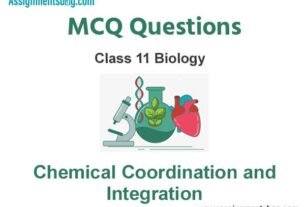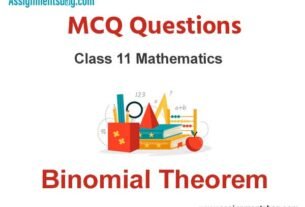Please refer to MCQ Questions Chapter 8 Cell The Unit of Life Class 11 Biology with answers provided below. These multiple-choice questions have been developed based on the latest NCERT book for class 11 Biology issued for the current academic year. We have provided MCQ Questions for Class 11 Biology for all chapters on our website. Students should learn the objective based questions for Chapter 8 Cell The Unit of Life in Class 11 Biology provided below to get more marks in exams.
Chapter 8 Cell The Unit of Life MCQ Questions
Please refer to the following Chapter 8 Cell The Unit of Life MCQ Questions Class 11 Biology with solutions for all important topics in the chapter.
MCQ Questions Answers for Chapter 8 Cell The Unit of Life Class 11 Biology
Question- Carotenoids
(a) Are fat soluble pigment
(b) Include carotene and xanthophyll pigment
(c) Are present in chloroplast
(d) All
Answer
D
Question- Endoplasmic reticulum is called RER when it has _____ on its surface
(a) Elementary particles
(b) Ribosomes
(c) Oxysome
(d) Quantasomes
Answer
B
Question- Ribosomes are found in all except
(a) Bacteria
(b) Mitochondria and chloroplast
(c) RER
(d) GB
Answer
D
Question- The membrane of the ER are continuous with the membrane of
(a) Nucleus
(b) Golgi body
(c) Membrane of mitochondria
(d) Membrane of plastid
Answer
A
Question- A cell which is very active in synthesis and secretion of proteins would be expected to have
(a) Equal amount of RER and SER
(b) More SER than RER
(c) More RER than SER
(d) More GB and no RER
Answer
C
Question- Packing of substances for export from the cell occurs in the
(a) SER
(b) GB
(c) Lysosyme
(d) Nucleolus
Answer
B
Question- Name of densely stained reticular structure have parallely stacked flat, disc shaped cisternae of 0.5mm diameter is
(a) ER
(b) GB
(c) Lysosome
(d) Microfilament
Answer
B
Question- Stacks of vesicles in chloroplast form
(a) Stroma
(b) Thylakoid
(c) Grana
(d) Oxysome
Answer
C
Question- Which of the following is correct about GB?
(a) GB is structurally and biochemically polarised
(b) The main function of GB is packing of materials, to be delivered to the intracellular targets or secreted outside
(c) The product that travels through GB are usually modified as they move from one cisternae to another
(d) All
Answer
D
Question- Which of the following enzymes is absent in lysosome?
(a) Lipases and Proteases
(b) Carbohydrates
(c) Hydrolase
(d) Nuclease
Answer
C
Question- Function of RER is
(a) autolysis
(b) protein synthesis
(c) lipid synthesis
d) carbohydrate synthesis
Answer
B
Question- Which of the following cell organelles were discovered after the introduction of electron microscope?
(a) Mitochondria
(b) Endoplasmic reticulum
(c) Ribosomes
(d) Both (b) and (c)
Answer
D
Question-In prokaryotes, chromatophores are
(a) specialized granules responsible for colouration of cells.
(b) structures responsible for organizing the shape of the organism.
(c) inclusion bodies lying free inside the cells for carrying out various metabolic activities.
(d) internal membrane systems that may become extensive and complex in photosynthetic bacteria.
Answer
D
Question- Electron microscope was invented by
(a) Robert Hooke
(b) Knoll and Ruska
(c) Pasteur
(d) Schwann and Schleiden
Answer
B
Question- DNA is present in
(a) chromosomes and dictyosomes
(b) chloroplasts and lysosomes
(c) mitochondria and chloroplasts
(d) mitochondria and endoplasmic reticulum
Answer
C
Question- Double membrane structure of cell are
(a) nucleus
(b) chloroplast
(c) mitochondria
(d) all of these
Answer
D
Question- In which of the following the cells are held together by a Ca-pectate layer?
(a) Primary cell wall
(b) Secondary cell wall
(c) Middle lamella
(d) Tertiary cell wall
Answer
C
Question- A prokaryotic cell lacks
(a) true nucleus
(b) nuclear membrane
(c) membrane bound organelles
(d) all of the above
Answer
D
Question- Which of the following is a single membranous structure ?
(a) Lysosome
(b) Nucleus
(c) Mitochondria
(d) Chloroplast
Answer
A
Question- Molecules that are too large to pass through the pores of a cell membrane may enter the cell by a process known as
(a) hydrolysis
(b) pinocytosis
(c) cyclosis
(d) synthesis
Answer
B
Question- In bacteria, site of respiration is
(a) mesosome
(b) episome
(c) plasmid
(d) cytoplasm
Answer
A
Question- Which of the following organelle is related with photorespiration?
(a) Peroxisome
(b) Nucleus
(c) Cell wall
(d) Lysosome
Answer
A
Question- Choose the incorrect match
(a) Nucleus — RNA
(b) Lysosome — Protein synthesis
(c) Mitochondria — Respiration
(d) Cytoskeleton — Microtubules
Answer
B
Question- Plasmodesmata connections help in
(a) cytoplasmic streaming.
(b) synchronous mitotic divisions.
(c) locomotion of unicellular organisms.
(d) movement of substances between cells.
Answer
D
Question- Hydrolytic enzymes are found in
(a) peroxisomes
(b) lysosomes
(c) lepdosomes
(d) lomasomes
Answer
B
Question- Three of the following statements regarding cell organelles are correct while one is wrong. Which one is wrong?
(a) Lysosomes are double membraned vesicles budded off from Golgi apparatus and contain digestive enzymes.
(b) Endoplasmic reticulum consists of a network of membranous tubules and helps in transport, synthesis and secretion.
(c) Leucoplasts are bound by two membranes,lack pigment but contain their own DNA and protein synthesizing machinery.
(d) Sphaerosomes are single membrane bound and are associated with synthesis and storage of lipids.
Answer
A
Question- What is common between chloroplasts,chromoplasts and leucoplasts?
(a) Presence of pigments.
(b) Possession of thylakoids and grana.
(c) Storage of starch, proteins and lipids.
(d) Ability to multiply by a fission-like process.
Answer
A
Question- Which of the following is responsible for mechanical support and enzyme transport ?
(a) Dictyosome
(b) Cell membrane
(c) E. R.
(d) Mitochondria
Answer
C
Question- Which of the following is responsible for the mechanical support, protein synthesis and enzyme transport?
(a) Cell membrane
(b) Mitochondria
(c) Dictyosome
(d) Endoplasmic reticulum
Answer
D
Question- Difference between the prokaryotic and eukaryotic cells in having
(a) cell wall
(b) nuclear membrane
(c) ribosome
(d) none of these
Answer
B
Question- “Omnis-cellula-e-cellula” was given by
(a) Virchow
(b) Hooke
(c) Leeuwenhoek
(d) Brown
Answer
A
Question- What is common between chloroplasts, chromoplasts and leucoplasts ?
(a) Presence of pigments.
(b) Possession of thylakoids and grana.
(c) Storage of starch, proteins and lipids.
(d) Ability to multiply by a fission-like process.
Answer
C
Question- Three morphological forms of golgi complex are
(a) Lamellae, tubules and vesicles
(b) Cisternae, tubules and vesicles
(c) Cisternae, tubules and lamellae
(d) Granum, thalykoids and vesicles
Answer
B
Question- Golgi apparatus is concerned with
(a) excretion
(b) secretion
(c) ATP synthesis
(d) RNA synthesis
Answer
A
Question- Which chromosome may lost during cell division?
(a) Giant chromosome
(b) Acentric chromosome
(c) Polycentric chromosome
(d) Telocentric chromosome
Answer
B
Question- Chromosomes with equal arms are called
(a) metacentric
(b) telocentric
(c) acentric
(d) polycentric
Answer
A
Question- Which of the following statements are correct ?
(i) In prokaryotic cells, a special membranous structure formed by the extension of the plasma membrane into the cell is known as polysome.
(ii) The smooth endoplasmic reticulum is the major site for synthesis of glycoproteins.
(iii) RuBisCO is the most abundant protein in the whole biosphere.
(iv) Mitochondria, chloroplasts and peroxisomes are not considered as part of endomembrane system.
(a) (iii) and (iv)
(b) (i) and (ii)
(c) (ii) and (iii)
(d) (i) and (iv)
Answer
A
Question- Who proposed the theory that “Cells arise only from the pre-existing cells”?
(a) Mohl
(b) Virchow
(c) Haeckel
(d) Brown
Answer
B
Question- The phagocytosis was first of all seen by
(a) Huxley
(b) Haeckel
(c) Metchnikoff
(d) Darwin
Answer
C
Question- An organalle devoid of membrane covering is
(a) vacuole
(b) ribosome
(c) peroxisome
(d) lysosome
Answer
B
Question- A chromosome with centromere at one end is called
(a) telocentric
(b) metacentric
(c) excentric
(d) apocentric
Answer
A
Question- Membranous extensions in blue green algae are known as
(a) phytochrome
(b) chromatophore
(c) mesosome
(d) pneumatophore
Answer
B
Question- Extension of plasma membrane in prokaryotic cell is
(a) mesosome
(b) haploid
(c) ribosome
(d) none of these
Answer
A
Question- Polysome is a chain of
(a) oxysomes
(b) sphaerosomes
(c) ribosomes
(d) dictyosomes
Answer
C
Question- Integral proteins of cell membrane occur on/in
(a) inner surfaces
(b) outer surfaces
(c) phospholipid matrix
(d) inner and outer surfaces
Answer
D
Question- Cristae helps in
(a) respiration
(b) photosynthesis
(c) transpiration
(d) guttation
Answer
A
Question- The lipid component of the membrane mainly consists of __________.
(a) polysaccharides
(b) phosphoglyceride
(c) monosaccharaides
(d) both (a) and (c)
Answer
B
Question- The best material for study of structure of cell membrane is
(a) RBC of human
(b) RBC of frog
(c) cheek cell of human
(d) liver cell of rat
Answer
A
Question- Which of the following is present between cell walls of the plant cells ?
(a) Lomasome
(b) Microsome
(c) Lysosome
(d) Middle lamella
Answer
D
Question- Rough E. R. differs from smooth E. R. due to the presence of
(a) DNA
(b) nucleus
(c) ribosome
(d) enzyme
Answer
C
Question- Which one of the following structures between two adjacent cells is an effective transport pathway?
(a) Plasmodesmata
(b) Plastoquinones
(c) Endoplasmic reticulum
(d) Plasmalemma
Answer
A
Question- Which of the following will determines the shape of the cells and provides a strong structural support to prevent the bacterium from bursting or collapsing?
(a) Plasmids
(b) Cell wall
(c) Mesosome
(d) Cell membrane
Answer
B
Question- Which one of the following is not considered as part of the endomembrane system?
(a) Golgi complex
(b) Peroxisome
(c) Vacuole
(d) Lysosome
Answer
B
Question- In many bacteria, cell membrane is invaginated and folded to form
(a) pili
(b) cristae
(c) flagella
(d) mesosome
Answer
D
Question- Genes present in the cytoplasm of eukaryotic cells, are found in
(a) mitochondria and inherited via egg cytoplasm
(b) lysosomes and peroxisomes
(c) Golgi bodies and’ smooth endoplasmic reticulum
(d) plastids and inherited via male gamete
Answer
A
Question- In nucleoplasm, a spherical body attached to a particular chromosome on a definite position is called
(a) nucleolus
(b) karyolymph
(c) plasmid
(d) reticulum
Answer
A
Question- _______________ is the important site of formation of glycoproteins and golycolipids.
(a) SER
(b) Lysosome
(c) Golgi apparatus
(d) Mitochondria
Answer
C
Question- Lysosomes contain
(a) carbohydrates
(b) hormones
(c) nucleic acids
(d) hydrolases
Answer
D
Question- Active transport across biomembrane involves
(a) production of ATP
(b) requirement of energy
(c) production of toxin
(d) release of energy
Answer
B
Question- The membrane of the erythrocytes has approximately___% of proteins and ___% lipids.
(a) 42, 50
(b) 52, 40
(c) 50, 50
(d) 60, 40
Answer
B

We hope you liked the above provided MCQ Questions Chapter 8 Cell The Unit of Life Class 11 Biology with solutions. If you have any questions please ask us in the comments box below.


